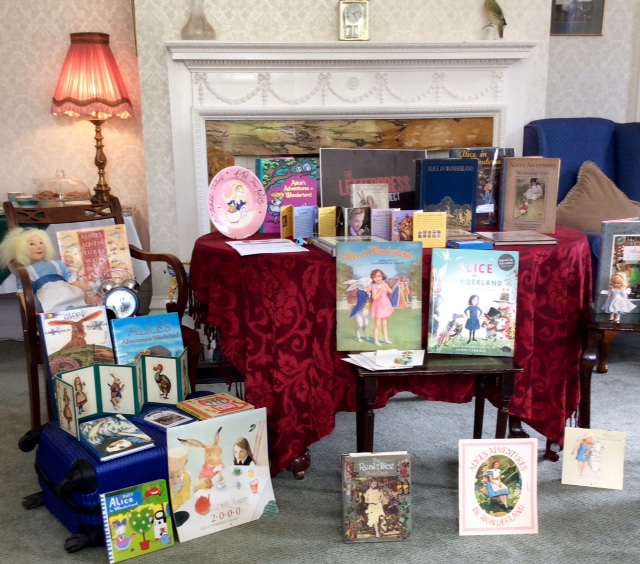Inspiring Older Readers
 posted on 12 Jul 2017
posted on 12 Jul 2017
Back down the rabbit hole
I enjoyed setting up my display of Alice books and artefacts in the elegant drawing room in the impressive Victorian house originally owned by the Perrins family ( of Lea and Perrins Worcestershire Sauce fame). This renovated building known as Davenham is now owned by Friends of the Elderly in Malvern, and is part of a large residential care complex made up of two other specialist facilities: Perrins House and Bradbury Court that all overlook splendid gardens and Malvern Common. I had been invited along by Ellie the activities co- ordinator who was keen for The Letterpress Project to offer the residents a different kind of experience from the usual. Two elderly ladies arrived and introduced themselves as the ' Two Marys' and they were soon followed by several others plus staff from the three different homes.
Once we had all settled down with a cup of tea and a jam tart, I started by telling them all about my collection and why I loved the classic story. As I talked about Lewis Carroll I was thrilled to hear from one of the Marys whose late husband was a GP, that she claimed a distant connection as one of his patients had been a close friend. Apparently this friend had owned a first edition of Alice's Adventures in Wonderland but she wasn't quite sure what had happened to it!
It had been very difficult to choose which books I should bring along and as usual had stuffed far too many as possible into my trusty trolley. I had decided to focus on four of the oldest ones from my collection just in case they triggered any memories for my elderly audience, most of whom were in their eighties. Sitting in a close circle, we passed around the one illustrated by Gwynedd M. Hudson ( 1928) with its beautiful gold embossed cover, much appreciated by those who had limited vision. Next came one of my personal favourites illustrated by Bessie Pease ( 1929) which seemed familiar to a couple of the ladies who spent some time looking closely at the distinctive pictures and smiling. Others seemed to respond to the dramatic black cover of the Harry Rountree (1940) version with the rather wolf like looking Cheshire Cat grinning at an Alice dressed in 1930s style clothes. The Rene Cloke edition (1945) again caused a small flurry of recognition and was easier for some of the less physically able residents to look at as it was a slimmer abridged version of the story.
I explained that I also had lots of Alice related artefacts as I was always on the lookout and that family and friends also tended to give me these as presents over the years. We passed around a heart shaped appliquéd tea tray made by my sister; an original drawing by a friend of the Mad Hatters Tea Party; a key ring; an alarm clock and a German Alice doll amongst many other interesting items. Once again - this seemed to be a particularly pleasurable experience for residents with limited vision.
I had also selected a few of my best loved modern versions of the story to show how different illustrators continue to interpret the story. I finished the talk with a flourish by showing them the extraordinarily impressive pop up version illustrated by Robert Sabuda which always gets a positive reaction from young and old.
The allocated hour passed very quickly and seemed to be enjoyed by everybody so I do hope that I will get the chance to visit this lovely group of people again in the near future.
Karen Argent
July 2017